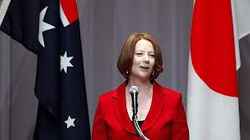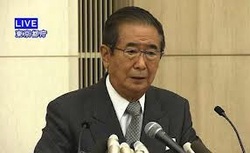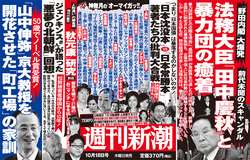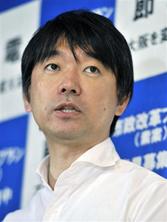 Photo: headlines.yahoo.co.jp
Photo: headlines.yahoo.co.jp To continue on from the previous post, in December of 2007 rumours began to surface that Hashimoto was considering running in the next prefectural governor election. On the 11th of December, media reports that Hashimoto was indeed set on entering the governor race were denied by Hashimoto himself, only for him to appear in a press conference on the 12th within the Osaka Prefectural Office to formally declare his intention to run for office. 『毎日新聞』2007年12月5日付朝刊, “[* 大阪府知事選:弁護士の橋下氏が出馬表明「大阪を元気に」]”. 毎日新聞 (2007年12月12日). According to Miyazaki Tetsuya, an analyst who often appeared on television programs with Hashimoto, the reason for his prevarication had more to do with his concern over securing enough finances to support his campaign than whether he should enter politics or not. “「二転三転は手続き上のこと」 橋下弁護士出馬会見詳報(4)”. 産経新聞 (2007年12月12日).
On the 7th of January 2008, both the LDP and the Komeito made clear their intentions to support Hashimoto at the prefectural level. The Osaka branch of Komeito were particularly encouraged by Hashimoto’s previous comments in relation to possession of nuclear weaponry, and so decided to switch their stance from “recommendation” of Hashimoto’s campaign to “support”, a position which the head branch of the Komeito also approved. At a function organised by the Komeito for the 16th of January, the parental organisation of the Komeito, the religious sect known as Soka Gakkai, called for support from its followers for Hashimoto’s campaign. The fact that Hashimoto had such a public profile coupled with a reputation for speaking his mind served him well on internet noticeboards. When details of his father’s association with organised crime came to light, internet criticism of those media organisations that ran the story reached a peak and cooled enthusiasm for pursuing the story.
In a press conference to outline his policy platform, Hashimoto explained to the assembled media that he would seek to increase the number of designated nursery schools within the prefecture, have rice distributed at mealtimes within public junior high schools, and have cobblestones and gas lamps installed in the central district of Osaka in order to create a more pedestrian-friendly environment. However when it became clear that these policies had been adopted by local governments outside of Osaka prefecture who had then imposed limitations on their (the policies’) usage, Hashimoto was called in for talks with LDP supporters and ordered to re-think his strategy.
As for bureaucratic reform of Osaka prefecture, Hashimoto had previously said that he would dismantle the prefectural office, “turn it on its head” and that any prefectural employee not pulling his or her weight was free to resign. This obviously would place him on a collision course with the bureaucrats of the prefecture, hence Hashimoto, after changing his tune, addressed staff of the prefectural office and asked them to become the “shields and sandbags” of Osaka and “join him in the scrum.” 『スポーツ報知』 2008年1月11日.
Hashimoto’s political platform:
The four key policies that Hashimoto eventually decided upon for his governor electoral campaign were as follows:
1. “An Osaka which children and adults can both enjoy”
(Hashimoto’s initial policy was particularly pro-family, and emphasised creating an Osaka in which children could be born and raised in safety, where they could attend schools in a more natural environment (i.e., increase the greenery), ensure that children can grow up properly though good nutrition, create the means by which schools could provide students with a fully realised education, give children a variety of prefectural high schools to choose from, make the most of volunteer and NPO activities, and give Osaka more specialist public hospitals).
2. “An Osaka where people meet, greet and which bustles with activity”
(This involved creating a system of effective subsidies, and creating the means by which people can gather in both retail and market areas).
3. “An Osaka where small to medium businesses can thrive, and where business is abundant”
(The entire prefectural government would work to support the growth of small to medium sized businesses, and also meet the needs of large scale industries. Osaka Prefectural University would also become a think-tank for Osaka as a whole).
4. “An Osaka where the people can see the prefectural government working for their benefit, and an Osaka where the people can take a leading role (in running the prefecture)”
(This policy envisaged an Osaka prefectural government cracking down on wasteful expenditure while also becoming an investment opportunity (thereby ushering in a prosperous era of regional government). Local governments would take over delivery of essential services (i.e., direct public services), while the prefectural government would re-organise those organs responsible for issuing directives on local matters along with those that decide on the direction the prefecture will take. According to Hashimoto, Osaka was rife with meaningless and wasteful projects. As such, any government that he run would only invest in projects which promised clear results. He would be thorough in enforcing accountability and transparency in government. In sum, he would create an Osaka in which all prefectural employees would exercise their “fighting spirit” in order to work for Osaka’s benefit and bring smiles to the faces of its residents).
Along with the four policies, Hashimoto followed this up with another 17 core projects that he would implement as governor:
1. (Possible title) Establish a “Child birth and rearing adviser” service
2. Promote emergency intake services for both obstetric and paediatric wards
3. Expand the number of general health checks for pregnant women
4. Expand the range of subsidies available for paediatric services
5. Expand subsidies to treat sterility
6. Develop more nursery facilities in front of and within railway stations
7. Establish a rent subsidy system for young couples with children
8. Support public activities for the disabled and elderly
9. Have all sports grounds at public elementary schools in Osaka prefecture change over to use of grass fields
10. Advocate the introduction of subsidised lunches at all public junior high schools in Osaka prefecture
11. Support the instalment of closed-circuit camera technology in order to create a safe and secure society
12. Hold a winter illumination event within Osaka prefecture
13. Create streets using “cobblestones and gas lamps”
14. Hold large scale conventions in order to stimulate the growth of small and medium sized businesses
15. Develop an active sales campaign led by the governor in order to increase Osaka’s level of activities
16. Fundamentally reform corporate bodies that receive investments from Osaka prefecture (apart from those deemed essential for everyday living)
17. Encourage the privatisation or sell-off of unnecessary public facilities and projects
Election Campaign
Hashimoto’s election campaign for governor was somewhat unusual in that neither the LDP nor the Komeito, which previously both advocated and supported Hashimoto, made their support public (instead keeping that support confined to conversations behind closed doors). As such, Hashimoto’s election campaign office was established within Titan Entertainment and was run by a number of Hashimoto’s old high school rugby team colleagues. This may have been a deliberate ploy to ensure that Hashimoto was not perceived as being too “tainted” by his association with other political parties. This “hands-off” strategy extended to Osaka representatives of the LDP and Komeito in the National Diet, none of whom made any speeches in support of Hashimoto. The only public support he gained was from other television and entertainment personalities such as recently elected House of Councillors member Maruyama Kazuya (a former regular on the Gyorestsu no dekiru Horitsu Sodansho program) and former comedian and the governor of Miyazaki prefecture, Higashikokubaru Hideo (otherwise known as Sonomanma Higashi).
Hashimoto used his large family as a selling point for his campaign, and created a manifesto around the catchphrase of “smiling children” along with his 17 core projects and 4 core policies (which he referred to as “tries”, again using a rugby metaphor). In the midst of the election campaign (January 20), around three million political leaflets criticising Hashimoto for remarks that he made on various television programs were inserted into advertising mail accompanying various newspapers which were then distributed around the prefecture (apparently this was the work of the office of another candidate, Kumagai Sadatoshi (formerly a member of the DPJ in the House of Representatives, now a member of Ozawa Ichiro’s People First party).
In the end Hashimoto was elected as prefectural governor by a huge margin of eight hundred thousand votes. His election marked a number of milestones. At the time of his election he was the youngest prefectural governor in all of Japan. It also marked the second time that Osaka had chosen to elect a so-called “entertainment governor” since Yokoyama Knock thirteen years earlier. He was the second serving governor to have a legal background (after the governor of Aichi prefecture Kanda Masaaki). Hashimoto was also the first governor of Osaka to have been born in Tokyo, and, as said earlier, was the third youngest governor in Japanese history having been elected at the age of 38.
After his election Hashimoto immediately began a series of media appearances. On the 29th of January he paid a courtesy call on the prime minister of the day, Fukuda Yasuo of the LDP. He also began his governor duties before being formally sworn in as governor. Borrowing an office from the Osaka branch of the LDP, Hashimoto began his term as governor by holding joint meetings on policy and the formation of the 2008 budget.
Governor of Osaka Prefecture
Announcement of a state of emergency concerning Osaka’s finances
On the 6th of February 2008 Hashimoto entered the Osaka Prefectural Office for the first time as governor. At a press conference held later in the day, Hashimoto declared that Osaka’s finances were in “a state of emergency”, and made it clear that the 2008 budget would see a reduction in spending of 10 billion yen (compared to the previous year), and emphasised his commitment to this goal by cutting his own retirement payout in half (to be received on retiring as governor). On the 5th of June, Hashimoto launched his “Program for Fiscal Rebuilding”, which outlined the main route the prefectural government would take in order to restore the financial health of the Osaka region. In line with his election pledge to “only create budgets within the limits of revenue”, Hashimoto set about re-examining a wide range of fiscal affairs involving operations, investments, and public utilities. As a result, in the course of 3 years there would be a reduction in costs to the tune of 24 billion yen while ensuring an income for the prefecture of 6.1 billion yen.
(The details of the program are outlined in the Japanese language version of Hashimoto’s on-line biography, found here).
At the press conference held on the 6th of February, Hashimoto backed up his electoral pledge to bring about a “thoroughly open government” by establishing an “Office of Open Information”. When asked what kind of information the office would provide, Hashimoto answered that, in essence, it would reveal everything. At another press conference on the 23rd of April, Hashimoto stated that… “freedom of information is absolutely crucial in order for a dictator-esque role such as prefectural governor to govern in a democratic manner” (J), and said that he aimed to make Osaka prefecture the most transparent in all of Japan.





 RSS Feed
RSS Feed